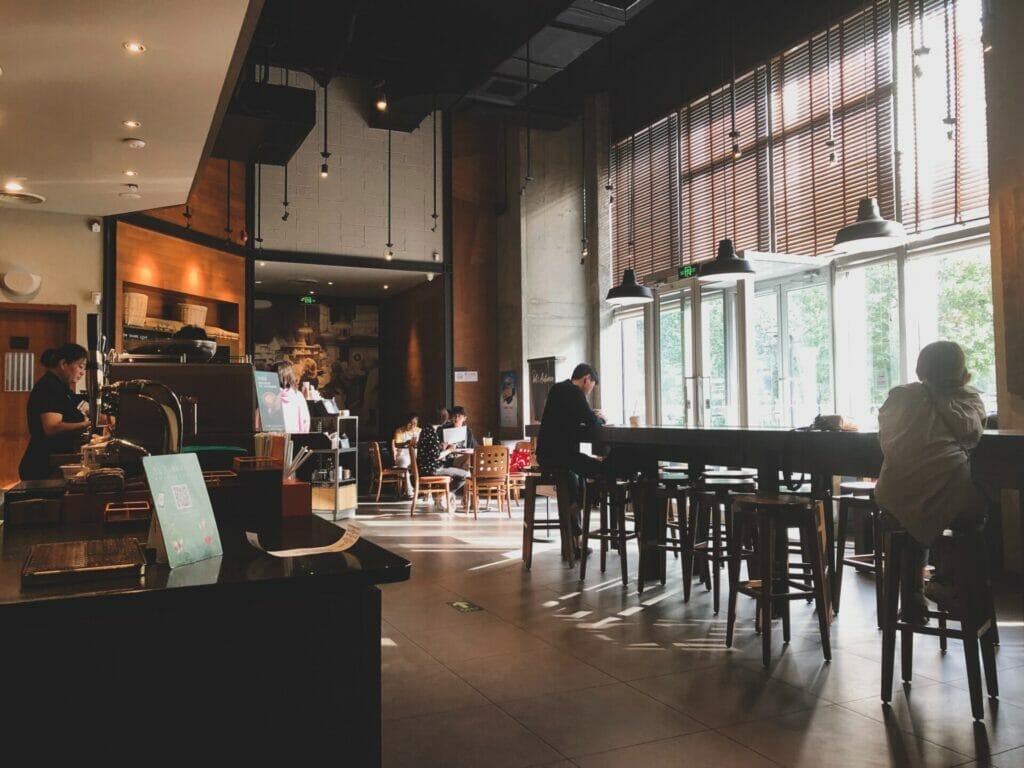How Much Profit Does A Coffee Shop Make?
One of the most popular questions people have about coffee shops is how much profit they actually make.
The answer, unfortunately, is not straightforward, as it depends on many factors such as location, number of customers served, and the type of coffee shop you are running. Generally speaking, however, a well-managed coffee shop can generate healthy profits ranging from 10 to 15 percent of its sales.
Depending on the success of your business, this percentage can increase exponentially over time. Factors that influence profitability include location selection, goods, and services offered, cost control measures employed, and how you choose to market your shop.
Maintaining a good relationship with suppliers by negotiating lower prices and creating loyalty programs can also help maximize your shop’s profits. Ultimately, it takes hard work and dedication to drive a successful coffee shop business but once everything is in place there are plenty of opportunities for generating returns if everything is supervised correctly.
How Long Does It Take For A Coffee Shop To Be Profitable?
Coffee shop business planning can be an incredibly rewarding venture, but it can also take some time before the business starts to see profits. On average, it takes between 6 to 12 months for a coffee shop to become profitable.

However, this timeline will depend on many factors such as initial startup costs and marketing efforts. Some establishments may achieve profitability much faster if they have a strong customer base or if their area has more foot traffic than others.
Having strong operational and financial management practices in place before setting up is also important for ensuring that you’re on the path to success from day one. Expenses need to be carefully monitored and budgets kept tight throughout the opening process.
Working with an experienced consultant is recommended for those who are looking to maximize their chances of success quickly.
By taking all of these steps into consideration, prospective coffee lovers should be able to create an effective plan that allows them to start making money within 6-12 months of their opening date. With proper planning and execution, any new business can become profitable soon after opening its doors!
Calculate Your Restaurant’s Profit Margin
If you’re an average coffee lover, calculating your profits is essential in understanding the success of your business. Knowing your restaurant’s profit margin helps to measure how much money your business is making and will give you an indication of how well it’s doing.
It goes without saying that accurate measurements are essential in understanding where improvements can be made or if costs need to be kept in check. To calculate coffee shop business revenue, you’ll need to consider several items including revenue from sales, wages, rent, utilities, and other miscellaneous costs.
By subtracting these costs from the total sales for the period, you get a better idea of the net income for that period. By looking at trends between long spans of time, you can gain insight into which areas are yielding more profit than others and make decisions to further increase margins accordingly.
So if you’re a coffee shop business owner wanting to maximize profitability, taking into account your restaurant’s profit margin is key!
Starting a coffee shop kiosk can be an amazing venture, but it takes more than just amazing coffee to make it successful. Having a solid idea of what you want your shop to be and the equipment needed to make it happen is essential. Average sales will depend on the quality of your product, the atmosphere you create, and how well you market your business.
Having additional coffee equipment such as espresso machines, grinders, and other specialty items can help increase average sales by providing customers with more options. Investing in quality equipment is also important for ensuring that customers have a great experience every time they visit your shop.
Creating loyalty programs and offering discounts are also great ways to encourage repeat customers and boost profits. Additionally, having an online presence can help spread the word about your business and attract new customers from all over the world.
With hard work and dedication, starting a successful coffee bar is possible! By taking into account all of these factors, you’ll be able to maximize profits while providing an amazing experience for all of your customers.
How Much Does It Cost To Open A Coffee Shop?
Your First Year Of Financing
When it comes to opening a coffee shop, the most important thing you need to worry about is your first year of financing. This includes the cost of rent, getting permits, purchasing supplies and equipment, hiring employees, setting up software and payment systems, marketing, and more!
Every coffee shop has different needs and planning requirements so it’s important to understand what your specific costs will be before diving in. Generally speaking though, there should be enough capital set aside to cover at least six months of expenses until profits can start rolling in.
It’s also highly recommended that the initial capitalization be anywhere between 10-25% of estimated first-year sales. Depending on the size and scope of your business this could vary dramatically but it should certainly account for any unforeseen risks or surprises along the way.
Ultimately your success relies on wise financial preparation and understanding what you’re committing to upfront.
Coffee Shop Prices On Average
The cost of opening a coffee shop depends on a number of factors, but to get an idea of the average costs associated with running one, you should understand what it entails. Prices for renting a suitable space, equipment, licensing costs, and staff can all add up.

On average, expect to pay between $50,000 and $75,000 just to get your business off the ground. This cost may vary depending on the location or size of your shop, but these figures should give you an idea of what kind of expenses you’ll face when starting your own café.
After that initial start-up investment comes the ongoing expenses such as supplies like cups of coffee with beans and milk, labor costs (including salaries for any employees), and utilities such as energy costs and internet access.
Altogether these mean that you’ll be looking at spending around $10-15 dollars every day your coffee shop is open. This again can vary by region or depending on the type of store you are running.
It’s also important to note that becoming a successful café owner doesn’t just depend on money; it also requires dedication to learn about the industry, drive sales receipts through marketing campaigns and provide excellent customer service which will keep people coming back for more!
Calculator For Opening A Restaurant
Opening up a restaurant requires both time and money. There are a variety of costs that you need to be aware of when determining the estimated budget for your venture, from rent and equipment to permits and staff members.
Fortunately, you don’t need to spend weeks figuring out the cost of everything — there is a calculator for opening a restaurant available online that can help you save time and keep your budget on track.
The calculator allows you to input all the necessary information into it so that it can accurately estimate how much approximately it will cost to open your restaurant. From kitchen equipment and rent costs to staffing expenses and local taxes – this calculator walks you through every aspect of starting up a business.
It even takes into consideration any potential additional fees like licensing or permits; additionally, the calculator allows you to go back and adjust the inputs as needed without having to redo everything from scratch.
Once finished, this helpful tool gives you an estimate of how much it will likely cost in order for you to open up your dream coffee shop! With its user-friendly interface, this calculator helps make tackling the daunting task of launching a business more manageable.
Forecasting Sales For Your Coffee Shop
Accurate forecasting of sales for your average coffee shop turnover is essential to running a successful business. It’s important to have an accurate understanding of how much product you need in order to meet demand, and how much profit you can make from it.
With this knowledge, you can budget accordingly and anticipate possible fluctuations in sales trends.
Forecasting the sales of your coffee shop means making predictions about what the future holds – examining past sales data, industry trends, market conditions, and customer preferences in order to make an educated guess about future success.
By analyzing key metrics such as conversion rate, average order value, and customer lifetime value, you can understand more accurately and anticipate upcoming performance.
With careful planning and sound forecasting methods, you’ll be able to confidently forecast the demand for your coffee shop and ensure that your store is always well-stocked with customers’ favorites. This will help increase profitability, enabling you to stay ahead of the competition or even steal a march on them!
Coffee Shop Revenue On Average
Coffee shop owners can be reassured that their businesses are successful and profitable on average. The data gathered from coffee shops around the world points to a strong, steady stream of income for these lucrative businesses. On average, coffee shop revenue is estimated to be anywhere between $10,000 and $40,000 per month.
Moreover, coffee shops often have very low overhead costs compared to other similar business types, increasing the overall profit margin. Regular customers that come in every day or week can add up significantly to the business’s bottom line while promotional strategies such as discounts and in-house events can bring in additional customers and subsequently more revenue.
Lastly, adding new products or services related to coffee such as pastries, food items or ice cream can also result in increased sales and profits. With the right management practices and marketing tools, it’s clear that a successfully run coffee shop brings significant earnings on average!

Monthly Profit Of A Coffee Shop
A coffee shop’s monthly profit can vary greatly depending on the number of customers it has, its location, and the prices it charges. It’s important to keep a close eye on revenue each month; this is the only way a business can have success in the long term.
Coffee shops typically depend on both six-time and repeat customers as well as impulse buyers who come in for a single cup of coffee or an item from the menu. Prices are usually set to cover costs and generate profits, which will help cover operational expenses like rent and wages.
In addition to keeping track of sales, managing inventory is crucial for ensuring that all necessary items are in stock at all times. This means understanding what items your customers are likely to purchase and stocking those items ahead of time so that you don’t run out when demand increases.
Running a successful coffee shop requires careful planning and budgeting. Business owners must consider fixed costs such as rent, utilities, and equipment, as well as monthly costs like wages and inventory. These expenses can quickly add up, so it’s important to keep track of them in order to stay profitable.
In addition to these costs, business owners must also factor in their own personal income. This is the money they will take home after all expenses have been paid. It’s important to remember that this income should be enough to cover living expenses and any other debt obligations.
By understanding the different types of costs associated with running a coffee shop and setting aside enough money for personal income, business owners can ensure that their businesses are profitable in the long run.
With careful planning and sound forecasting methods, they’ll be able to confidently forecast the demand for their coffee shop and ensure that their store is always well-stocked with customers’ favorites. This will help increase profitability, enabling them to stay ahead of the competition or even steal a march on them!
Salary Of A Coffee Shop Owner
Owning a coffee shop may sound like a dream job to many, but it’s also an incredibly demanding and tough venture. Rarely do cafe owners become wealthy from their business, as there are myriad factors at play when calculating the salary they can expect to receive.
The salary of a coffee shop owner largely depends on the success of their business. If the cafe is bringing in significant profits, only then will it be able to command a comfortable income. Other factors at play that influence their salary include their location, the size of the establishment, and the number of staff employed.
For those that are devoted to making their cafe a success, managing it well and keeping up with current trends can lead them to reap greater rewards down the line – financially speaking. The average monthly salary for most successful coffee shop owners stands at $4-5K per month depending on these parameters mentioned prior.

Street lighting is an important part of any city or town, providing a safe and secure environment for pedestrians and drivers alike. For independent shops, street lighting can be a great way to attract customers and increase visibility. However, installation costs can be quite high, making it difficult for small businesses to invest in this type of marketing.
The target market for street lighting is typically those who live in the area or frequent the area regularly. This means that independent shops must consider their target market carefully when deciding whether or not to invest in street lighting.
It’s important to remember that installation costs are only one part of the equation; there are also ongoing marketing costs associated with maintaining the lights and ensuring they remain attractive to potential customers.
Ultimately, investing in street lighting can be a great way for independent shops to increase visibility and attract more customers. However, it’s important to weigh up the installation costs as well as ongoing marketing costs before making a decision. With careful consideration and planning, street lighting can be an effective tool for increasing foot traffic at independent shops.
Timeline For Breaking Even
Making a profit with a coffee shop requires careful planning and dedication. Knowing how much time it will take to break even is essential for providing an accurate financial outlook.
Generally speaking, it typically takes three to five months for a coffee shop to turn a profit. But this timeline can vary depending on the size of the store, location, and other factors.
In the first two months after opening, most coffee shops operate at a loss while they accumulate sales to build their client base. During this period, all profits made are used to cover overhead costs such as payroll taxes and utilities.

Once these expenses are paid up and more regular sales start coming in from customers, then the coffee shop will be able to break even by month three or four (at the latest).
From there, continuing sales should bring about steady profits each month depending on how well-managed the type of coffee business is run and its ability to maintain customer loyalty. With proper planning and dedication, you’ll be able to make your dream of owning your own business come true!
Increasing The Sales Of Your Coffee Shop
If you’re looking to increase the profitability of your coffee kiosk, it pays to understand what strategies will get you the highest profits. There are several ways to increase sales and profits at your average coffee shop, such as offering discounts and loyalty programs, implementing efficient marketing tactics, and optimizing pricing.
More importantly, you should create a positive customer experience that encourages customers to come back again and again.
The most important factor in increasing sales is providing an outstanding product and service. Investing time and resources into developing a top-notch menu can make all the difference in drawing in customers willing to pay full price.
Drawing on customer feedback, engaging with customers via social media, and properly training staff—all these things contribute towards creating a business that stands out from its competitors.
Increasing profits through smart pricing is one way you can ensure your business remains economically sustainable. Analyzing customer data trends to determine prices for peak times during rush hour or after work hours will let you maximize revenues without sacrificing quality or service.
Additionally, killing deals with coupons or promotions when needed helps bring new customers through your doors who may become regular patrons. At the end of the day, with diligent attention paid to both generating more sales and focusing on profit-improving measures, any coffee industry can become wildly successful!
